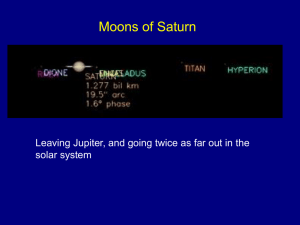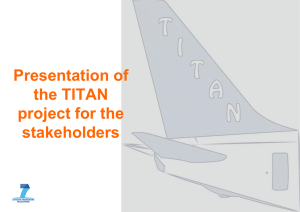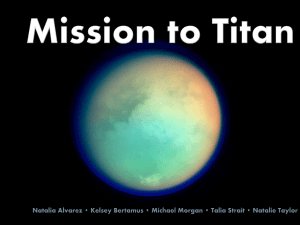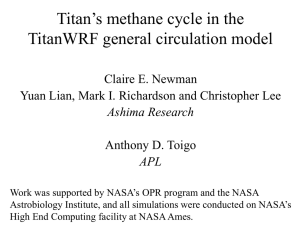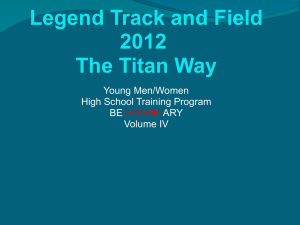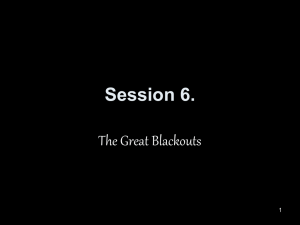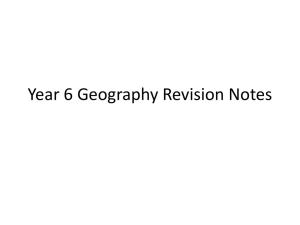A New Titan GCM and Stratospheric Superrotation
advertisement
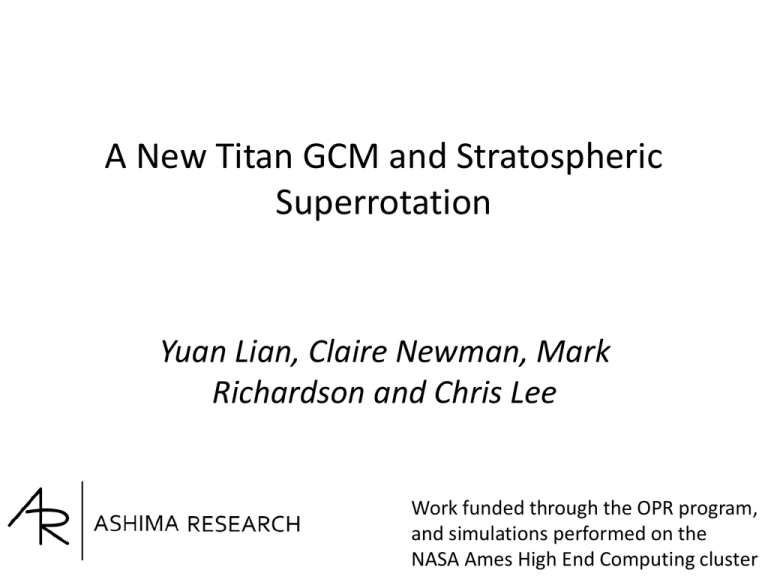
A New Titan GCM and Stratospheric Superrotation Yuan Lian, Claire Newman, Mark Richardson and Chris Lee Work funded through the OPR program, and simulations performed on the NASA Ames High End Computing cluster Goals of this work • To reproduce key aspects of Titan’s circulation in a 3-dimensional general circulation model (GCM) • To form a robust understanding of the dynamical mechanisms responsible • To produce robust predictions of seasonal changes in Titan’s circulation Comparing the TitanWRF GCM with observations In previous work, we simulated strong, realistic stratospheric superrotation and seasonal change similar to that observed -- Pressure (mbar) Zonal winds in northern summer Zonal winds in southern summer 1e-3 TitanWRF predictions for same times 1e-2 1e-1 1e0 1e1 -90 1e2 1e3 -60 -30 0 30 Latitude (deg N) 60 90 Zonal winds from CIRS in 2005 (Ls~293-323°) 1e-3 1e-2 1e-1 1e0 1e1 -60 1e2 1e3 -30 0 30 Latitude (deg N) 60 Zonal winds from CIRS in 2011 (Ls~2026°) [from Achterberg et al.] -90 -60 -30 0 30 Latitude (deg N) 60 90 Discrepancies between TitanWRF and observations Zonal wind peaks at a lower altitude than observed (likely due to the ‘low’ model top and/or the lack of active haze advection) Pressure (mbar) CIRS zonal winds for Ls~293-323° Also, no lower stratosphere zonal wind minimum as seen by Huygens and also Cassini (Flasar, 2012) TitanWRF zonal winds for same period Stratospheric superrotation in TitanWRF d(angular momentum)/dt in kg m2/s2 We find superrotation is produced by episodic ‘transfer events’ Equatorial dM/dt (22.5°S to 22.5°N) Northern dM/dt (Pole to 22.5°N) Southern dM/dt (Pole to 22.5°S) Planetocentric solar longitude (in ° Ls) Rate of change of angular momentum in 3 regions over a Titan year Stratospheric superrotation in TitanWRF Angular momentum ‘transfer events’ between northern/southern hemisphere and equatorial region, in northern/southern late fall-spring Planetocentric solar longitude (in ° Ls) Momentum transport during a ‘transfer event’ Unstable region develops on low-latitude flank of ~winter zonal jet Waves carry westward angular momentum -> jet => accelerate low latitudes Waves break depositing westward angular momentum => decelerate high latitudes In TitanWRF we found too much atmospheric mixing disrupts these delicate wave processes, leading to weak stratospheric circulations Questions we wanted to answer Question 1: Does another GCM using identical radiative forcing produce a similar circulation? - This is actually a well-known problem in Titan modeling Question 2: Do we see episodic ‘transfer events’ in a different Titan GCM? - How robust is our proposed superrotation mechanism? Question 3: How delicate are the wave interactions involved in driving Titan’s equatorial superrotation? - Was the need to minimize mixing limited to TitanWRF? We examined two GCMs and four setups. Setups 1 & 2 used our first Titan GCM, TitanWRF… 1. TitanWRF [Newman et al., Icarus, 2011] • Lat-lon grid, finite-difference solver 2. TitanWRF with a ‘rotated pole’ • Numerical pole and ‘polar’ filtering now at the equator Filtering to avoid instabilities where grid spacing is small Grid rotated through 90° …while setups 3 & 4 used our new second Titan model, the Titan MITgcm 3. Titan MITgcm [Mars version described in Lian et al., Icarus, 2012] • Lat-lon grid, finite-volume solver 4. Titan MITgcm using ‘cubedsphere’ grid • No singularities at poles • ‘Special points’ at cube corners Which produced realistic superrotation? 1. TitanWRF with a standard lat-lon grid 2. Titan MITgcm with a standard lat-lon grid Which had problems? 2. TitanWRF with rotated pole 4. MITgcm with cubed-sphere grid What do the problem set-ups have in common? TitanWRF with rotated pole Titan MITgcm with cubed-sphere grid Has filtered regions at both numerical poles Has 6 special ‘corner’ points In both cases, we’re ‘messing with’ the low- to midlatitudes where the waves are produced that are crucial to driving superrotation Superrotation index for the MITgcm lat-lon grid Superrotation index = mass-weighted angular momentum of layer that of same layer at rest wrt the solid surface Superrotation index for the MIT cubed-sphere grid Far weaker superrotation is achieved with the cubed-sphere grid Questions we wanted to answer Question 3: How delicate are the wave interactions involved in driving Titan’s equatorial superrotation? - Was the need to minimize mixing limited to TitanWRF? Answer from this work: The dynamics of the low- to mid-latitudes should be treated very carefully to avoid disrupting vital wave-mean flow interactions - This does not seem to be limited to TitanWRF dM/dt in kg m2/s2 TitanWRF dM/dt in kg m2/s2 Another year of TitanWRF Planetocentric solar longitude (in ° Ls) dM/dt in kg m2/s2 TitanWRF dM/dt in kg m2/s2 Titan MITgcm Planetocentric solar longitude (in ° Ls) Questions we wanted to answer Question 2: Do we see episodic ‘transfer events’ in a different Titan GCM? - How robust is our proposed superrotation mechanism? Answer from this work: Momentum transport in the Titan MITgcm is remarkably close to that in TitanWRF despite big differences in dynamical core / numerics - The mechanism appears to be quite robust The circulation in TitanWRF and the MITgcm Comparing winds at Ls = 270°: TitanWRF has larger peak wind speeds, but Titan MITgcm simulates a strong zonal wind minimum Pressure (mbar) TitanWRF Titan MITgcm The circulation in TitanWRF and the MITgcm Comparing temperatures at Ls = 270°: largely look very similar, but slight variations can have a big impact on dynamics Pressure (mbar) TitanWRF Titan MITgcm Questions we wanted to answer Question 1: Does another GCM using identical radiative forcing produce a similar circulation? - This is actually a well-known problem in Titan modeling Answer: Many similarities, but differences in detail: e.g. superrotation strength; sharper vertical gradients - Much more to investigate here! Conclusions • At Ashima we now have two superrotating Titan GCMs with similarly realistic circulations: TitanWRF and Titan MITgcm • Our proposed mechanism for the production of equatorial stratospheric superrotation in TitanWRF – via ‘episodic transfer events’ – is supported by Titan MITgcm results • As found before, GCM set-ups that disrupt the low- to midlatitudes (e.g. too much diffusion, filtering, etc.) disrupt the delicate wave momentum transports responsible • Titan MITgcm also captures far more of the observed zonal wind minimum above the tropopause than TitanWRF – Could be due to improved accuracy of temperature advection – However, tropospheric wind speeds in Titan MITgcm are too small Future work • Raise the model top for both models to cover more of the haze production zone • Turn on radiatively active advection of haze particles to enable feedbacks between haze distribution, heating and circulation • These changes should allow a stronger circulation to develop and reduce interference by the model top, thus improving the match to observations Tropospheric methane ice cloud predicted by TitanWRF More future work: study the CH4 cycle in the MITgcm!
